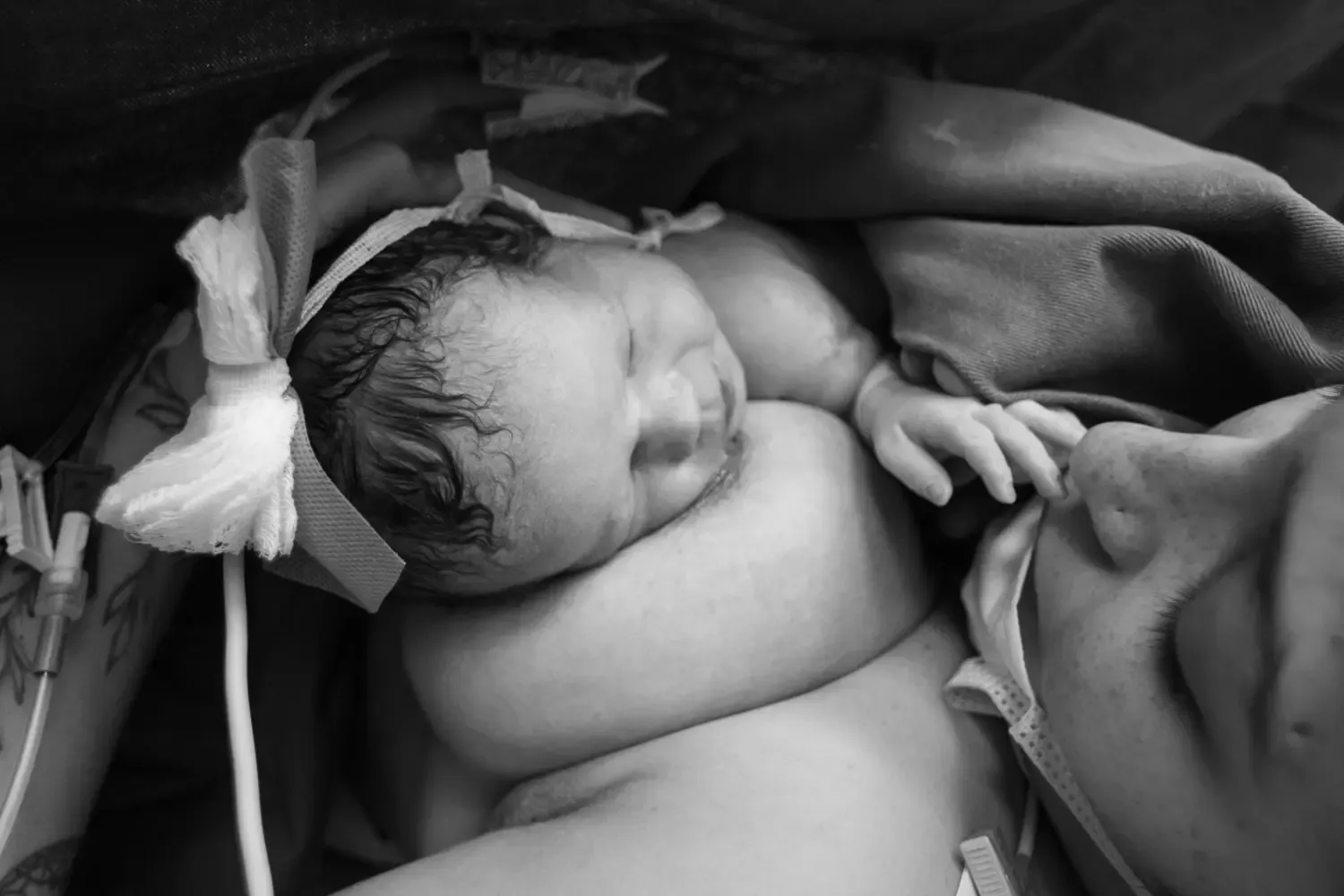Early skin-to-skin contact gives newborns a stronger start

Newborns who are placed skin-to-skin with their mother directly after birth show better health outcomes, according to an updated review of extensive research. The contact supports the infant’s basic bodily functions and increases the likelihood of breastfeeding – yet it is still not standard practice in all healthcare systems.
Allowing the newborn to rest directly on the mother’s chest after delivery may be more significant than many realise. A recent update of an international Cochrane review, with researchers Wibke Jonas, Kristin Svensson and Siri Lilliesköld from Department of Women's and Children's Health at KI, clearly shows that immediate skin-to-skin contact between mother and child improves several important health measures during the first period of life.
The review includes 69 studies involving more than 7,000 mother–infant pairs and reveals that infants who experience early skin-to-skin contact are better able to regulate body temperature and blood sugar levels after birth. They breathe more efficiently, adapt more easily to life outside the womb, and cry less. In addition, the likelihood of exclusive breastfeeding during the first six months increases.
“We can confirm that skin-to-skin contact is a simple, cost-free, and an effective method for promoting newborn health,” says Wibke Jonas, researcher at the Department of Women’s and Children’s Health at Karolinska Institutet.
Potential benefits for the mother have also been studied, such as effects on blood loss after delivery and placental expulsion, but the evidence in these areas is still uncertain.
Despite the accumulated research, skin-to-skin contact is not standard practice in all areas of healthcare, particularly not in more complicated births such as caesarean sections.
“It is important for healthcare to focus on implementing skin-to-skin contact, even after more complicated births such as caesarean sections,” says Wibke Jonas.
The research group is now continuing to investigate the effects in very preterm infants through the Immediate Parent Infant Skin to Skin Contact Study (IPISTOSS). The study examines both short- and long-term outcomes, including breastfeeding rates, parent–infant interaction, and biological changes potentially influenced by early contact.
“Having the updated review published now means a lot. It provides us with a stronger scientific basis for continuing to promote skin-to-skin contact as a natural part of care,” concludes Wibke Jonas.
Importantly, the review also highlights that further randomised controlled trials comparing skin-to-skin contact with ‘standard care’ are no longer ethically justifiable.
Read the article here
- Lilliesköld, S., Lode-Kolz, K., Westrup, B., Bergman, N., Sorjonen, K., Ådén, U., Mörelius, E., Rettedal, S., & Jonas, W. (2025). Skin-to-skin contact at birth for very preterm infants and symptoms of depression and anxiety in parents during the first year – A secondary outcome of a randomized clinical trial. Journal of Affective Disorders, 383, 323–332. https://doi.org/10.1016/j.jad.2025.04.160
- Lode-Kolz K, Jonas W, Hetland HB, Hovland Instebø KH, Tokvam H, Pike H, Lilliesköld S, Klemming S, Linnér A, Ådén U, Rettedal S. Immediate Skin-to-Skin Contact at Very Preterm Birth and Neurodevelopment the First Two Years: Secondary Outcomes from a Randomised Clinical Trial. Children (Basel). 2025 Jul 27;12(8):986. doi: 10.3390/children12080986.
- Johansson, MW., Lilliesköld S., Jonas W., Thernström Blomqvist Y., Skiöld B., & Linnér A. (2024). Early skin-to-skin contact and the risk of intraventricular haemorrhage and sepsis in preterm infants. Acta Paediatr, 113(8):1796-1802. doi: 10.1111/apa.17302.
- Lilliesköld, S., Lode-Kolz, K., Rettedal, S., Lindstedt, J., Linnér, A., Markhus Pike, H.,…Jonas, W. (2023). Skin-to-Skin Contact at Birth for Very Preterm Infants and Mother- Infant Interaction Quality at 4 Months: A Secondary Analysis of the IPISTOSS Randomized Clinical Trial. JAMA Network Open, 6(11), e2344469. doi: 10.1001/jamanetworkopen.2023.44469
- Lode-Kolz, K., Hermansson, C., Linnér, A., Klemming, S., Hetland, H. B., Bergman, N., Lilliesköld S.,… Rettedal, S. (2023). Immediate skin-to-skin contact after birth ensures stable thermoregulation in very preterm infants in high-resource settings. Acta Paediatr, 112 (5), 934-941. doi:10.1111/apa.16590
- Linnér, A., Lilliesköld, S., Jonas, W., & Skiöld, B. (2022). Initiation and duration of skin-to- skin contact for extremely and very preterm infants: A register study. Acta Paediatr, 111(9), 1715-1721. doi:10.1111/apa.16433
- Linnér, A., Lode Kolz, K., Klemming, S., Bergman, N., Lilliesköld, S., Markhus Pike, H., . . . Jonas, W. (2022). Immediate skin-to-skin contact may have beneficial effects on the cardiorespiratory stabilisation in very preterm infants. Acta Paediatr, 111(8), 1507- 1514. doi:10.1111/apa.16371
- Lilliesköld, S., Zwedberg, S., Linnér, A., & Jonas, W. (2022). Parents' Experiences of Immediate Skin-to-Skin Contact After the Birth of Their Very Preterm Neonates. J Obstet Gynecol Neonatal Nurs, 51(1), 53-64. doi:10.1016/j.jogn.2021.10.002
- Linnér, A., Westrup, B., Lode-Kolz, K., Klemming, S., Lilliesköld, S., Markhus Pike, H., . . . Jonas, W. (2020). Immediate parent-infant skin-to-skin study (IPISTOSS): study protocol of a randomised controlled trial on very preterm infants cared for in skin-to- skin contact immediately after birth and potential physiological, epigenetic, psychological and neurodevelopmental consequences.. BMJ Open, 10(7), e038938. doi:10.1136/bmjopen-2020-038938
- Linnér, A., Klemming, S., Sundberg, B., Lilliesköld, S., Westrup, B., Jonas, W., & Skiöld, B. (2020). Immediate skin-to-skin contact is feasible for very preterm infants but thermal control remains a challenge. Acta Paediatr, 109(4), 697-704. doi:10.1111/apa.15062
